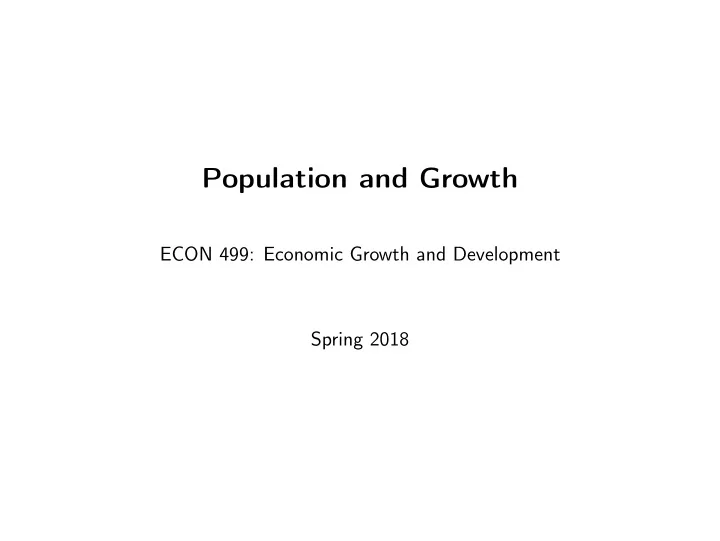

Population and Growth ECON 499: Economic Growth and Development Spring 2018
Announcements ◮ Reading ◮ Chapters 4 ◮ Meet here on Thursday (no lab) ◮ Homework due on Thursday (uploaded to Canvas) ◮ Expect technological "hiccups"
Population and growth ◮ More people means more mouths to feed ◮ More people also means more workers ◮ How does production per capita respond to population growth?
Malthusian model ◮ Thomas Malthus (1766-1834) ◮ Productive resources are scarce , sometimes finite (land) ◮ As population increases, land per person decreases, making people worse off ◮ As poverty increases, people start dying and having fewer children, causing population to fall ◮ Population and income are self-regulating, mankind "stuck" at subsistence income level ◮ Malthus’s solution: "Moral restraint"
Breakdown of the Malthusian Model
Explaining population growth ◮ Solow model predicts that increased population growth can decrease income through capital dilution ◮ Population growth in Solow model is exogenous , determined outside the model ◮ Population growth usually modeled as demographic transition ◮ Developing countries go through mortality and fertility transitions as they develop
Mortality transition ◮ Life expectancy at birth: number of years a newborn baby in a given year will live on average ◮ Most countries have seen life expectancy increase over last few centuries, beginning with developed countries ◮ Three factors: 1. More plentiful, nutritious food 2. Public health: sanitation, clean water, etc 3. Medical technology
Fertility transition ◮ Total fertility rate: number of children the each woman would have if she lived through child-bearing age ◮ Fertility rates decreased rapidly in developed world ◮ Decreasing in developing world, but still higher than developed world ◮ Possible explanations: 1. Contraception 2. Declining mortality 3. Income and substitution effects 4. Quantity/quality tradeoff
Contraception ◮ Fertility rates began declining in developed world long before contraception was widely available ◮ Fertility in developing world decreasing contemporaneously with contraception ◮ Micro studies: ◮ Making contraception available decreases number of offspring ◮ Decreases unwanted pregnancies ◮ Increases female "bargaining power", agency
Mortality reduction ◮ Perhaps parents don’t care about the number of children, but rather the number that survive to adulthood ◮ If mortality rates are high, parents will want more children to ensure more adult children ◮ Declining mortality rates will mean fewer children, effects likely delayed
Income and substitution effects ◮ Rising income means people can afford more of everything, including children (income effect) ◮ Rising income means the opportunity cost of children is higher (substitution effect) ◮ If substitution effect dominates, people want fewer children as income rises ◮ In developing countries, female wages generally rise faster than male, substitution effect higher for women
Quantity/quality ◮ Development increases opportunities for children ◮ Parents may invest more in children’s education, knowing payoffs are higher ◮ This leaves less resources for other children ◮ Parents choose having fewer, higher quality children
Demographic transition ◮ In general, mortality rates decline before fertility rates ◮ We can model population growth as a demographic transition ◮ Falling mortality rates give rise to increasing population until fertility declines as well
https://ourworldindata.org/grapher/ child-mortality-vs-population-growth?time=1970..2015
Fertility in the developed world ◮ Fertility rates in many developed countries are well below "replacement level" ◮ Should expect declining populations (Japan projected to lose 29% of population by 2055) ◮ Tempo effect: women delaying children can "artificially" reduce fertility rates but maintain constant population ◮ Increasing wages and political freedom for women can increase tempo effects
HIV/AIDS ◮ 90% of infected people live in developing countries ◮ 5% of SSA infected (25% in Botswana) ◮ Reverses many of the mortality gains experienced elsewhere ◮ Life expectancy decreased 15 years in SSA
Aging ◮ Declining mortality rates mean more people live into old age ◮ Declining fertility rates mean there are fewer children ◮ Median global age will increase 10 years by 2050 ◮ Only workers create output, retired people don’t work
Working-age fraction of US population
GDP per capita and aging ◮ GDP per worker = GDP/(# of workers) ◮ GDP per capita = GDP/(total population) GDP workers GDP per capita = workers × population workers GDP per capita = GDP per worker × population ◮ GDP per capita can decrease even as GDP per worker increases
Recommend
More recommend